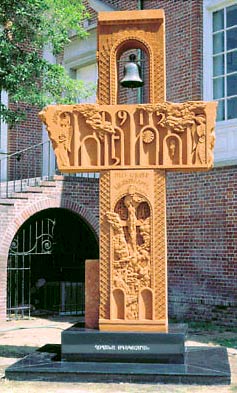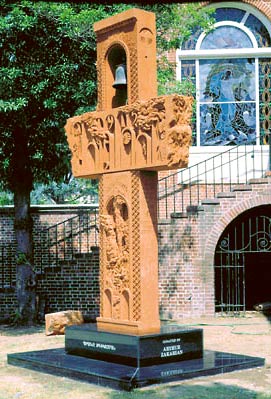
Armenian Genocide
Khachkar
Sculpture by Gaspar
Gharibyan
Photos and Text courtesy of ©ArmeniaGuide.com
http://www.armeniaguide.com/

|
A Khachkar is a monument reflecting Armenian medieval culture and has been traditionally erected in holy and public places for national and personal divine reasons and purposes. The word Khachkar translates literally to "Cross Rock" or "The Rock of the Cross". The art of sculpting the ornamental relief style of Khachkar reached the peak of its progress in the 13th century Armenia. This unique work of religious art gained international recognition and respect. Unveiled on Sunday, July 23, 2000, following the Sunday Services at the St. Mary's Armenian Apostolic Church in Glendale, CA is the second Khachkar in the history of America. This Khachkar was sponsored by the Zakarian Family, dedicating it to the memory of the martyrs of the Armenian Genocide. It is again the work of master sculptor Gaspar Gharibyan. The Armenian Genocide, perpetrated by the Young Turks government of the Ottoman Empire from 1915 to 1923 became the first holocaust of the 20th century. As a result of this genocide, a majority of centuries-old Armenian historical and religious artifacts were lost forever. From the depths of the 85 years since the genocide, the memory of the victims of the Armenian Genocide is resurrected here as a tolling of commemoration. This monument is constructed from "Touf" stone, which was also brought in from Armenia. The three large pieces assembled together to represent a cross have unique carvings, symbolizing the will and the determination of the Armenian people to survive. This Khachkar emerges from a granite base, shattering the grief and becoming a crucifix of hope. The base is also divided into five sections, characterizing the five continents of the world, on which rests the monument memorializing the victims of the Armenian Genocide. From the center of the cross hangs the universal heart of love and charity which has cracked and is bleeding onto the strained and saddened Cross due to the tragedy of the holocaust. The 12 empty altars on one of the Cross represent the 12 regions depleted of their indigenous Armenian people. The date marking the beginning of the Armenian Genocide is pierced through the eye of the being, as a sign of survival and perseverance. The fireball of eternity represents the strong future of the Armenian people. The edges of the cross are etched with the storms of time. Angles stand vigil at the altars and in one of the altars, the universal eye keeps a hopeful watch. From the arch at the top of the cross hangs the eternal bell, which continuously tolls in the name of reparation. The Genocide does not transcend time. The protective eagle on its side - the symbol of the USA - characterize eternal justice. |

Sculpture Gallery Cross Art Gallery
| Credits: Armenian Genocide Khachkar, Sculpture by Gaspar Gharibyan. Photographs and Text courtesy of ©ArmeniaGuide.com. Used by permission of Rouben Malayan; photos and text may not be reproduced without prior written permission of ArmeniaGuide.com. ArmeniaGuide.com
|